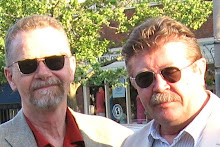
Pictured: Erika Sunnegårdh
JOHN COULBOURN, Special to TorSun
25 APRIL 2013
R: 4/5
TORONTO - The opera, it seems, is no place for escapists these days — at least not here in Toronto. Hot on the heels of last week’s opening of David Alden’s blood-soaked and definitely Dickensian take on Donizetti’s Lucia di Lammermoor at the Four Seasons Centre, the Canadian Opera Company Sunday took its audience on a another dark and bloody trip. The destination? A somewhat reworked version of Richard Strauss’ SALOME as envisioned by director Atom Egoyan, who has already helmed two productions of the work for Toronto audiences, in 1996 and 2002.
And for those asking “Has his SALOME aged like fine wine, or simply grown older?,” the answer is: “A little bit of both. On the plus side, Egoyan has arguably never had finer tools with which to paint his soundscape, led here by soprano Erika Sunnegårdh, bringing a wonderful touch of child-like malice to the title role. With mezzo Hanna Schwarz as her grasping mother, Herodias, and tenor Richard Margison as her malignant royal stepfather, this is a family with problems of biblical proportions, all brought to a head by the capture and imprisonment of Jochanaan (John the Baptist), a small but pivotal role magnificently sung by baritone Martin Gantner, who will be replaced by Alan Held for the final four performances of the run.
The supporting cast is equally impressive, featuring debuting talents like tenor Nathaniel Peake as a love-struck Narraboth teamed with familiar talents like tenors Michael Colvin, Michael Barrett and Adam Luther and soprano Claire de Sévigné in supporting turns. Meanwhile, under the baton of Johannes Debus, the COC Orchestra is on hand to give a finely-etched and sensitive reading of Strauss’ complex score.
As for the story, it will be familiar to even the most casual biblical scholars, although it has been given a few fine fin-de-siècle twists by Oscar Wilde, upon whose play both Hedwig Lachmann’s libretto and Strauss’s often atonal and once ground-breaking score is based.
And, over the course of three productions, Egoyan has brought much to the story, too, layering on filmed and video effects, shadow plays and psychological motivations until Derek McLane’s stark and other-worldly rhomboid-riddled set, magnificently lit by Michael Whitfield, is fairly awash.
But in the end, it all plays out in with a terrible familiarity: Spurned by the prophet, SALOME gains her revenge, trading on her stepfather’s lust-fuelled ardour to secure the head of his prisoner in exchange for the legendary dance of the seven veils, used here as a tool to explore the biblical femme fatale’s damaged inner psyche. But at a certain point — somewhere between the numerous close-ups of Gantner’s admittedly magnificent and hard-working uvula and the inevitable speculation as to why both a sword and a wood axe are required to relieve John of his head — it all becomes more about the production than the story it is telling For all his tweaking, Egoyan has overlooked the fact that while it may not always breed contempt, familiarity can certainly play hell with shock value.



No comments:
Post a Comment